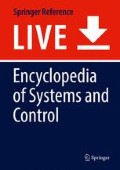Abstract
In order to avoid suboptimal collective behaviors and resolve social dilemmas, researchers have tried to understand how humans make decisions when interacting with other humans or smart machines and carried out theoretical and experimental studies aimed at influencing decision-making dynamics in large populations. We identify the key challenges and open issues in the related research, list a few popular models with the corresponding results, and point out future research directions.
Bibliography
Baillieul J, Leonard NE, Morgansen KA (2012) Interaction dynamics: the interface of humans and smart machines. Proc IEEE 100:567–570
Bernardo JM (1994) Bayesian theory. Wiley, Chichester
Bitzer S, Park H, Blankenburg F, Kiebel SJ (2014) Perceptual decision making: drift-diffusion model is equivalent to a Bayesian model. Front Hum Neurosci (102) 8:1–17
Broder A, Schiffer S (2004) Bayesian strategy assessment in multi-attribute decision-making. J Behav Decis Mak 16:193–213
Cao M, Stewart A, Leonard NE (2010) Convergence in human decision-making dynamics. Syst Control Lett 59:87–97
Centola D, Willer R, Macy M (2016) The emperor’s dilemma: a computational model of self-enforcing norms. Am J Sociol 110(4):1009–1040
Evans NJ, Holmes WR, Trueblood JS (2019) Response-time data provide critical constraints on dynamic models of multi-alternative, multi-attribute choice. Psychon Bull Rev 26:193–213
Gisches EJ, Rapoport A (2012) Degrading network capacity may improve performance: private versus public monitoring in the Braess paradox. Theor Decis 73: 901–933
Granovetter M (1978) Threshold models of collective behavior. Am J Sociol 83:1420–1443
Mas M, Opp K-D (2016) When is ignorance bliss? Disclosing true information and cascades of norm violation in networks. Soc. Networks 47:116–129
Myerson RB (1991) Game theory: analysis of conflict. Harvard University Press, Cambridge/London
Ostrom E (2008) Tragedy of the commons. The new palgrave dictionary of economics. Palgrave Macmillan, UK, pp 3573–3576
Ramazi P, Riehl J, Cao M (2016) Networks of conforming or nonconforming individuals tend to reach satisfactory decisions. Proc Natl Acad Sci 113(46):12985–12990
Ratcliff R (1978) A theory of memory retrieval. Psychol Rev 85:59–108
Ratcliff R, Smith PL, Brown SD, McKoon G (2016) Diffusion decision model: current issues and history. Trends Cogn Sci 20(4):260–281
Reverdy P, Llhan BD, Koditschek DE (2015) A drift-diffusion model for robotic obstacle avoidance. In: Proceedings of the 2015 IEEE/RSJ international conference on intelligent robots and systems (IROS), number 15666827. IEEE
Riehl J, Ramazi P, Cao M (2018) A survey on the analysis and control of evolutionary matrix games. Ann Rev Control 45:87–106
Rossi W, Como G, Fagnai F (2019) Threshold models of cascades in large-scale networks. IEEE Trans Netw Sci Eng 6:158–172
Sandholm WH (2010) Population games and evolutionary dynamics. MIT Press, Cambridge
Steinberg R, Zangwill WI (1983) The prevalence of Braess’ paradox. Transp Sci 17:301–318
Stewart A, Cao M, Nedic A, Tomlin D, Leonard AE (2012) Towards human-robot teams: model-based analysis of human decision making in two-alternative choice tasks with social feedback. Proc IEEE 100(3):751–775
Woodruff C, Vu L, Morgansen KA, Tomlin D (2012) Deterministic modeling and evaluation of decision-making dynamics in sequential two-alternative forced choice tasks. Proc IEEE 100(3):734–750
Author information
Authors and Affiliations
Corresponding author
Editor information
Editors and Affiliations
Section Editor information
Rights and permissions
Copyright information
© 2020 Springer-Verlag London Ltd., part of Springer Nature
About this entry
Cite this entry
Cao, M. (2020). Human Decision-Making in Multi-agent Systems. In: Baillieul, J., Samad, T. (eds) Encyclopedia of Systems and Control. Springer, London. https://doi.org/10.1007/978-1-4471-5102-9_100124-1
Download citation
DOI: https://doi.org/10.1007/978-1-4471-5102-9_100124-1
Published:
Publisher Name: Springer, London
Print ISBN: 978-1-4471-5102-9
Online ISBN: 978-1-4471-5102-9
eBook Packages: Springer Reference EngineeringReference Module Computer Science and Engineering

